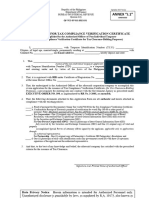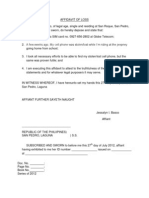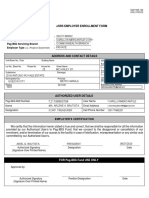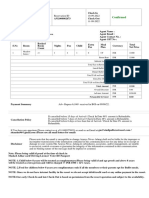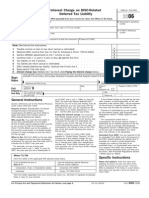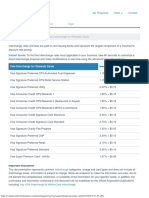SSS Contribution Table As of January 2007
SSS Contribution Table As of January 2007
Uploaded by
ahnzloveCopyright:
Available Formats
SSS Contribution Table As of January 2007
SSS Contribution Table As of January 2007
Uploaded by
ahnzloveOriginal Title
Copyright
Available Formats
Share this document
Did you find this document useful?
Is this content inappropriate?
Copyright:
Available Formats
SSS Contribution Table As of January 2007
SSS Contribution Table As of January 2007
Uploaded by
ahnzloveCopyright:
Available Formats
SSS Contribution Table as of January 2007
Philhealth premium contribution Jan 2009
RA 9504 : REVISED WITHHOLDING TAX TABLES EFFECTIVE 2009
SEPTEMBER 11, 2008 BY RISKSOFBUSINESS 178 COMMENTS RA 9504 has a transitional withholding taxes table and in which that I have posted in my topic, IMPLEMENTING GUIDELINES OF RA 9504, are to be used effective July 2008 to December 2008. The transitional withholding tax tables have been devised to aide in computing for withholding taxes of employees as an effect on the pro-rata application of the NEW TAX EXEMPTIONS. However, effective January 2009, the 2009 REVISED WITHHOLDING TAX TABLE shall be used to address by then the full implementation and application of the NEW TAX EXEMPTIONS as provided for in RA 9504. It is the responsibility of employers making payment of compensation to deduct and withhold a portion of an employee's pay a tax determined in accordance with the 2009 REVISED WITHHOLDING TAX TABLE. There are two basic ways on computing for withholding taxes. It could either be through the use of the REVISED WITHHOLDING TAX TABLE or the ANNUALIZED METHOD. Let us focus on the method of using the revised withholding tax table for purposes of this discussion. There are four (4) withholding tax
tables prescribed in the IMPLEMENTING GUIDELINES OF RA 9504, namely: (a) Monthly Tax Table, which is to be used by employers whose employees are paid once a month. (b) Semi-Monthly Tax Table, which is used by employers using the semi-monthly payroll period. The Semi-monthly manner of computing withholding taxes is the most commonly used type. (c) Weekly Tax Table, which is used by employers whose employees are paid on a weekly basis. And (d) Daily Tax Table, which is used by employers using the daily payroll period. The components of the REVISED WITHHOLDING TAX TABLE is grouped into Tables A and B. Table A is used for employees with no Qualified Dependent Child (QDC) and Table B is used for employees with QDC. The columns in the tables reflect the following: (a) 1st column reflects the exemption status of employee represented by letter symbols. (b)2nd column reflects the total amount of personal and additional exemption, in pesos, to which an employee is entitled. (c) Column numbers 1 to 8 reflect the portion of the amount of taxes to be withheld on the amount of compensation of the employees. Every amount in all the columns within Tables A and B represent the compensation level. (d) Legend of symbols The symbols used in the REVISED WITHHOLDING TAX TABLE represents tax status of employees: Z Zero exemption, S ingle, legally separated spouses/widow/widower, ME Married employee who is not legally separated, Exemption means the amount of exemption in thousand pesos an employee is entitled to claim as a deduction from gross compensation income in accordance with the status and number of qualified dependent children (QDC). The numerals (1-4) affixed to the status symbols and represent the number of qualified legitimate, illegitimate, or legally adopted children.
You might also like
- 100 Journal EntriesDocument10 pages100 Journal Entriessahilsingh667% (46)
- 1 Application For CPA ID PDFDocument1 page1 Application For CPA ID PDFalpha novell70% (10)
- Sample Template For Exemption CertificateDocument1 pageSample Template For Exemption Certificatemagdalena angeles50% (4)
- HLF111 CertificateEngagement V05Document1 pageHLF111 CertificateEngagement V05julesniko23No ratings yet
- Application For Tax Compliance Verification Certificate Non-Individual TaxpayersDocument1 pageApplication For Tax Compliance Verification Certificate Non-Individual TaxpayersanabuaNo ratings yet
- SSSForm Affidavit Separation From EmploymentDocument1 pageSSSForm Affidavit Separation From Employmentfpmaypa71% (7)
- Lessees Information Statement For BIR 2Document2 pagesLessees Information Statement For BIR 2Blue Heavens100% (2)
- Letter PcsoDocument1 pageLetter PcsoDee ComonNo ratings yet
- Letter of Request For DeactivationDocument1 pageLetter of Request For DeactivationRonald Leabres100% (1)
- Sworn Statement (RMO 15-2018)Document2 pagesSworn Statement (RMO 15-2018)Christian Albert Herrera100% (1)
- Annex J.1Document1 pageAnnex J.1Vina Mae Lacang100% (4)
- Secretary Certificate Lost PlateDocument1 pageSecretary Certificate Lost PlateAiza VillanuevaNo ratings yet
- Request For Certified True Copy of ITRDocument1 pageRequest For Certified True Copy of ITRGeraldine GuingabNo ratings yet
- Letter of Request For Retirement and Termination of BusinessDocument1 pageLetter of Request For Retirement and Termination of BusinessEdward Isip80% (5)
- Philippine Health Insurance Corporation: Data Amendment Request Form General InformationDocument1 pagePhilippine Health Insurance Corporation: Data Amendment Request Form General InformationiKON IC100% (3)
- Certificate of ResignationDocument1 pageCertificate of ResignationSsej PCNo ratings yet
- Request For Amendment of SSS Web Employer ProfileDocument1 pageRequest For Amendment of SSS Web Employer Profilejeziel salazar100% (1)
- Annex F RR 11-2018Document1 pageAnnex F RR 11-2018Andoy Domingo Carullo100% (2)
- New Pagibig STLRF FormatDocument6 pagesNew Pagibig STLRF FormatNen Mar0% (2)
- Annex DDocument1 pageAnnex DAnthonyNo ratings yet
- SWP Application PacketDocument7 pagesSWP Application PacketGemma RetubaNo ratings yet
- Letter of Request Manual PaymentDocument1 pageLetter of Request Manual PaymentNoan Siman100% (3)
- CERTIFICATION TCG 2019Document1 pageCERTIFICATION TCG 2019Ren A EleponioNo ratings yet
- Sworn Annex ADocument1 pageSworn Annex Arhianne_lhen5824No ratings yet
- Opening Balance As Of: 47,889.36: Description Reference Value Date Debit Credit DateDocument1 pageOpening Balance As Of: 47,889.36: Description Reference Value Date Debit Credit DateSayed Rasully SadatNo ratings yet
- Affidavit of LossDocument1 pageAffidavit of LossKristine Artes Aguilar0% (1)
- Affidavit of Non OperationDocument1 pageAffidavit of Non OperationJong Perraren100% (3)
- PhilHealth Letter of RequestDocument1 pagePhilHealth Letter of RequestMark Kevin IIINo ratings yet
- Social Security System: Collection List Thru UsbDocument8 pagesSocial Security System: Collection List Thru UsbLala MagayanesNo ratings yet
- Sss Deletion Request of Contri For Late Salzar CrisaldoDocument1 pageSss Deletion Request of Contri For Late Salzar CrisaldoRobert Mequila IINo ratings yet
- SEC. CERT. BlankDocument1 pageSEC. CERT. BlanklouryNo ratings yet
- Secretary's Certificate ReceiptsDocument1 pageSecretary's Certificate ReceiptsImelda Purificacion0% (1)
- Sworn Declaration BirDocument1 pageSworn Declaration Birynid wageNo ratings yet
- RMO 12 2013 List of Unused Expired ORsSIsCIs Annex DDocument2 pagesRMO 12 2013 List of Unused Expired ORsSIsCIs Annex DMIS MijerssNo ratings yet
- Letter of Intent BIR-eFPSDocument1 pageLetter of Intent BIR-eFPSsheNo ratings yet
- Annex B - Delinquency Verification Certificate 1 CorrectedDocument2 pagesAnnex B - Delinquency Verification Certificate 1 CorrectedKirk Yngwie Enriquez100% (1)
- Affidavit of Retirement-SssDocument2 pagesAffidavit of Retirement-SssSORITA LAWNo ratings yet
- Letter For Tax ClearanceDocument1 pageLetter For Tax ClearanceProbinsyana Ko0% (1)
- Annex E-1 - Installment ProposalDocument2 pagesAnnex E-1 - Installment ProposalAtty Tanglao100% (1)
- FPF060 Membership Contributions Remittance Form (MCRF)Document2 pagesFPF060 Membership Contributions Remittance Form (MCRF)Mathenie David56% (9)
- BIR Tax Clearance FORM - Non Individual 2023Document2 pagesBIR Tax Clearance FORM - Non Individual 2023janetNo ratings yet
- AUTHORIZATION LETTER - Pag IbigDocument1 pageAUTHORIZATION LETTER - Pag IbigFeliz NavidadNo ratings yet
- Sales and Tax Declaration Form 2020Document1 pageSales and Tax Declaration Form 2020k act100% (1)
- Sworn Application For Tax Clearance IndividualDocument1 pageSworn Application For Tax Clearance Individualmarcj engineering100% (5)
- eSRS Reg Form PDFDocument1 pageeSRS Reg Form PDFDarlyn Etang100% (2)
- Annex A C of RMC No. 57 2015Document13 pagesAnnex A C of RMC No. 57 2015Cheresse Agrabio RanarioNo ratings yet
- Authorization Letter MERALCODocument3 pagesAuthorization Letter MERALCOAlbert LopezNo ratings yet
- Secretary's Certificate - Tax ClearanceDocument1 pageSecretary's Certificate - Tax ClearanceGlenn DomingoNo ratings yet
- Endorsement Letter For Tenant PassDocument1 pageEndorsement Letter For Tenant PassCardo Dalisay100% (1)
- Sworn Application For Tax Clearance - Non-IndDocument2 pagesSworn Application For Tax Clearance - Non-Indejay niel100% (1)
- Affidavit of Non Operation TerryDocument1 pageAffidavit of Non Operation TerryRaysunArellanoNo ratings yet
- Authorization Letter DTIDocument2 pagesAuthorization Letter DTIJane Kathyrine Lim-MarquezNo ratings yet
- Authorization Letter BxuDocument1 pageAuthorization Letter BxuJanaelaNo ratings yet
- Revenue District Office No. 27 - Caloocan: NO. RR No. Rdo No. Bank Code Bank Name Bank Branch Bank AddressDocument2 pagesRevenue District Office No. 27 - Caloocan: NO. RR No. Rdo No. Bank Code Bank Name Bank Branch Bank AddressCharina Marie CaduaNo ratings yet
- Certificate of Non OperationsDocument1 pageCertificate of Non OperationsKielRinonNo ratings yet
- Rdo 45Document2 pagesRdo 45cel1978No ratings yet
- Affidavit of No Pending CaseDocument1 pageAffidavit of No Pending CaseManny SandichoNo ratings yet
- Authorization LetterDocument1 pageAuthorization LetterRoseshel BarrunNo ratings yet
- Certificate of No EmployeeDocument1 pageCertificate of No EmployeeradzNo ratings yet
- Annex F RR 11-2018 EXCELDocument1 pageAnnex F RR 11-2018 EXCELMarfin M. Ramos75% (4)
- Affidavit of Non - OperationDocument1 pageAffidavit of Non - OperationRap Macalino100% (1)
- 1604 and OthersDocument86 pages1604 and OthersBradley WhiteheadNo ratings yet
- Chapter 8-1. ProblemsDocument10 pagesChapter 8-1. ProblemsCloudKielGuiangNo ratings yet
- Payslip - 2021 03 29Document1 pagePayslip - 2021 03 29Loan LoanNo ratings yet
- GST Unit IiDocument20 pagesGST Unit IiMani Maran123No ratings yet
- Deiz-Spire Tech-InvoiceDocument3 pagesDeiz-Spire Tech-InvoiceKath HernandezNo ratings yet
- E-Service Complaint FormDocument1 pageE-Service Complaint FormGbadeyanka O WuraolaNo ratings yet
- TaxationDocument11 pagesTaxationAnonymous ougAoiPZNo ratings yet
- Instruction: Please Provide The Needed Information and Mark With Check of TheDocument11 pagesInstruction: Please Provide The Needed Information and Mark With Check of TheDHARLIN JEAN CHAVEZNo ratings yet
- Daily Wages 2024 SK FEDDocument2 pagesDaily Wages 2024 SK FEDJay DeeNo ratings yet
- SBI Bank Statement (Aug - Oct)Document7 pagesSBI Bank Statement (Aug - Oct)BEENA JOSHINo ratings yet
- Customer Name Card Account No MR Chandrashekar K 4375 XXXX XXXX 6003Document5 pagesCustomer Name Card Account No MR Chandrashekar K 4375 XXXX XXXX 6003Chandrashekar KNo ratings yet
- Schedules of Alphanumeric Tax Codes Nature of Income Payment TAX Rate ATC Nature of Income Payment TAX Rate ATC IND Corp Ind CorpDocument1 pageSchedules of Alphanumeric Tax Codes Nature of Income Payment TAX Rate ATC Nature of Income Payment TAX Rate ATC IND Corp Ind CorpMhyckee GuinoNo ratings yet
- 20180410122326XXXXXXX0418 PDFDocument3 pages20180410122326XXXXXXX0418 PDFNagaraj KumarNo ratings yet
- Rental InvoiceDocument1 pageRental Invoicedc464tzvtvNo ratings yet
- PGBP Chart 1Document2 pagesPGBP Chart 1Aashish Kumar Singh100% (1)
- Paper F6 Revision Questions and AnswersDocument90 pagesPaper F6 Revision Questions and AnswersAwais Anwar KhanNo ratings yet
- Myrna Keith - Employer Package PDFDocument24 pagesMyrna Keith - Employer Package PDFJoey KeithNo ratings yet
- G.R. No. 196596Document23 pagesG.R. No. 196596Ann ChanNo ratings yet
- Vistaland Intl Notes2021Document11 pagesVistaland Intl Notes2021Myda RafaelNo ratings yet
- Brochure ReceiptDocument1 pageBrochure ReceiptSilvy srishtyNo ratings yet
- Audit 2 Modul Ke 11 Pert Ke 12Document18 pagesAudit 2 Modul Ke 11 Pert Ke 12della dfapNo ratings yet
- MR Ashish GuptaDocument1 pageMR Ashish GuptaAshish GuptaNo ratings yet
- Canara - Epassbook - 2024-05-25 115523.060043Document102 pagesCanara - Epassbook - 2024-05-25 115523.060043vemalokesh619No ratings yet
- PDF Proforma Invoice To Poland PDF CompressDocument1 pagePDF Proforma Invoice To Poland PDF Compressliviu.catalin2011No ratings yet
- F 3949 ADocument3 pagesF 3949 Aiamsomedude100% (3)
- Albilad Credit Card Application-EnDocument6 pagesAlbilad Credit Card Application-EnHABEEB RAHMANNo ratings yet
- Interest Charge On DISC-Related Deferred Tax Liability: Sign HereDocument2 pagesInterest Charge On DISC-Related Deferred Tax Liability: Sign HereIRSNo ratings yet
- UntitledDocument11 pagesUntitledTYBFM A 137 SHAH BHAVYANo ratings yet
- Visa Rewards RatesDocument2 pagesVisa Rewards Rateslwalker1545No ratings yet




